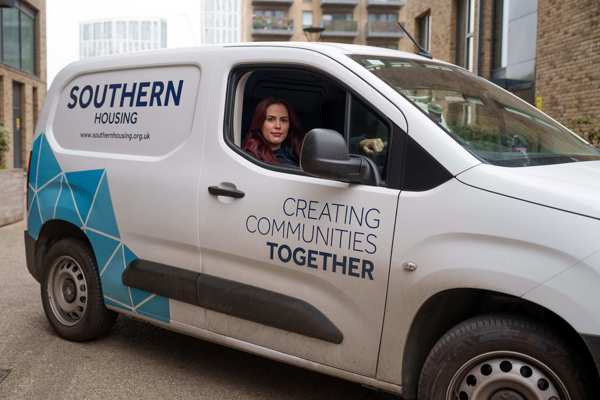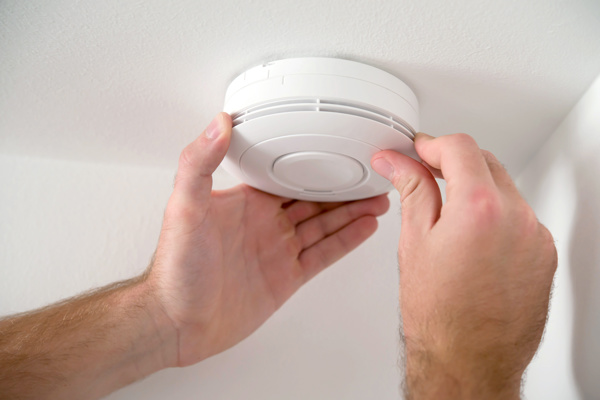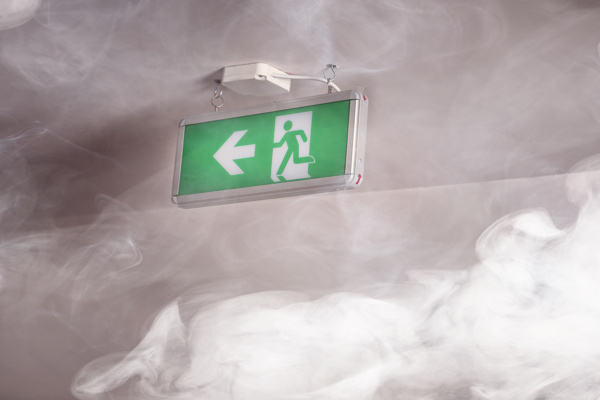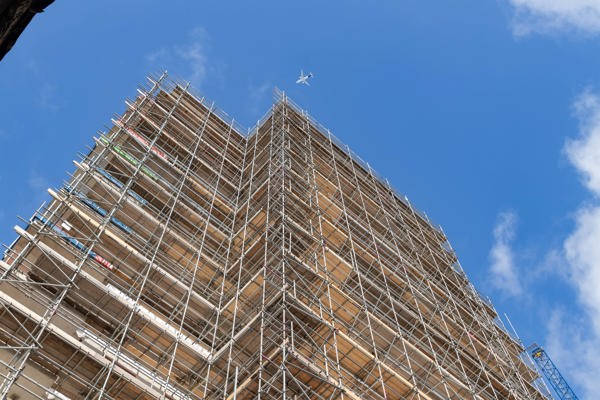General fire safety
There are lots of things you can do to ensure you’re fire safe in your home. You’ll find a wide range of information on our website.
This covers a number of topics including smoke alarms, candles, BBQs, plugs and electricals, electric bikes and e-scooters.
View our fire safety advice- Ensure smoke alarms are present and working in your flat.
- Ensure your flat entrance door is able to close by itself (there should be a self-closer attached).
- Report any concerns about fire safety in the building to us: firesafety.risk@southernhousing.org.uk
- Get out, close the front door behind you and make your way to a safe place away from the building.
- Call the Fire Brigade as soon as possible and provide information about the fire.
- Do not re-enter the building for any reason until you are told it is safe to do so by a fire officer.
If anyone in your household requires special assistance evacuating your building, please contact us so we can understand the support you require.
We may arrange for an Evacuation Steward to be present to assist with personal evacuations, if we feel this is necessary.
Contact usFire safety inspections and action
In the letter or calling card you received about a fire inspection visit, you’ll find contact information for the contractor carrying out the appointment.
If you contact them directly they’ll be able to change your appointment to a more convenient time for you.
If you’re unable to find your letter or calling card please contact us.
Contact usPlease allow between 30 and 90 minutes for the appointment, it varies from home to home depending on the work that’s needed.
Please make sure you, or someone over 18 will be home at the time of the appointment. Please keep young children and pets away from the work area.
Finally, please check the ID of our engineer when they arrive, so you know who they are.
- Complete the essential safety work
- Identify anything further that’s needed and arrange for this to be completed at a future date
- Treat you and your home with courtesy and respect.
We’re legally required to carry out Fire Risk Assessments for all blocks of flats. We must also legally have a “Responsible Person” who’s accountable for the building’s fire safety.
The job of this person is to make sure all relevant fire safety tasks are carried out.
They make sure any necessary action is taken to prevent fires, or death or injury, if a fire takes place.
The responsible person must ensure a valid Fire Risk Assessment is made on your building.
The recent Fire Risk Assessment carried out in your building may have identified certain works, maintenance and repairs that are needed to reduce the risk of fire within your building.
We’re legally required to complete any actions following a Fire Risk Assessment.
Regulations, guidance and legislation changes over time.
What was acceptable 10 years ago (in building design and management), may no longer be considered appropriate now.
A Fire Risk Assessment will look the building, assess the risks and decide if upgrades, repairs or changes are needed to improve the level of safety.
Firestopping is the sealing of any openings to prevent fire, smoke, and heat from passing throughout a building.
The spread of fire is contained by creating fire resisting compartments (i.e. around a flat, or corridor etc.). Where cables and pipes pass through walls or ceilings there are often holes and gaps present.
The process of fire stopping seals these holes with fire resisting materials which minimises the spread of a fire within a building.
Passive fire protection is an important part of our fire safety strategy. It’s built into the structure of a building to protect lives and limit the damage to buildings and their contents. It does this by:
- Limiting the spread of fire and smoke by containing it in a single compartment
- Protecting escape routes for essential means of escape
- Protecting the building structure thereby ensuring it’s sustainability.
This is essential fire safety works and so it is crucial you give us access to complete the work.
We’ll always try and work with you to get dates and times that best fit.
If access is not granted, then we’ll follow a no access process which could lead to court action being taken against you.
We want our services to be as accessible as possible for you.
Please contact us to discuss what adjustments we could put in place to help you with this visit.
Contact usWe’ll leave a resident’s satisfaction survey card for you to complete when we visit.
Or, you can find out more about how to share feedback with us here on our website.
How to share your feedback with usWe encourage you to get in touch with us about anything you’re not happy with. We can use this information to learn and improve.
You can make a complaint by calling us, or visiting our complaints page.
Make a complaintThey are chosen from a list of approved contractors who have been rigorously checked before they can work for Southern Housing.
Fire door inspections
We carry out regular fire door checks in your building.
This is a vital inspection as fire doors play an essential role in preventing or inhibiting the spread of smoke, toxic gases and fire in the event that a fire breaks out.
The contractor will only need a couple of minutes to complete the inspection of your front door.
- If there are any gaps around the door frame
- If seals and hinges are fitted correctly
- That the door closer shuts the door
- That the door closes correctly around the whole frame
- That there’s no visible damage to the door, or door closer
- If there’s been any alterations or damage to windows or vents in the door.
If we identify an issue with your door, we’ll arrange for our local contractor to complete a repair or install a replacement.
They’ll contact you with an appointment for this work
Due to the scale of the programme, we aren’t booking individual appointments at this time.
Our contractor will visit each building approximately every 3 months to complete inspections.
During the initial rounds of visits, the contractor will call into your building and attempt to access as many homes as possible.
Set appointment dates will be arranged for any homes they’ve not been able to access during these visits as we near the end of the programme.
Our contractors may attend your building and place a small QR code label on every door within the communal areas, including flat entrance doors.
The QR code labels are small and discreet, measuring 20mm x 20mm. See image to the right.
This label allows us to record information on the type/condition of the door and to keep a log of future inspections.
A survey of your door may identify repair issues that could stop the door reacting as we’d expect if there was a fire.
To ensure it does operate as a fire door should, we may need to carry out some upgrades so it is compliant with fire safety standards.
A new fire door usually takes 12-15 weeks to arrive.
To replace a front door will usually take us around half a day.
When an appointment is made to replace your door, the contractor will provide further information on this.
An intumescent strip is a thin seal usually fixed around the edges of a fire door.
The intumescent material expands when heated up and blocks the small spaces between the door which reduces the chance of fire and smoke spreading throughout the building.
Door lipping is where an additional hardwood strip is added to the sides or base of a door.
This is usually required where gaps are present around door leaf's or where the edge of the door gets damaged over time.
Instead of needing to replace a complete door it can be 'lipped' to create a new flush edge to the door, which helps the door to fit tightly into its frame.
Fire safety regulation say that all flat entrance doors need to be fitted with a door closer.
This is because a fire door will only be effective in preventing fire spread if it's closed.
The door therefore needs to be fitted with a compliant self-closing device (an overhead door closer).
Please contact us if you’ve any mobility issues we need to be aware of as we can offer you an easy opening closer
Contact usIt may be that your door was checked by our Fire Risk Assessment consultant and identified as needing work.
Please don’t be concerned, your neighbours' doors are also on our programme to check and complete any works required.
Following the Grenfell fire tragedy, the Ministry of Housing, Communities and Local Government (MHCLG) began investigating the fire door industry.
They specifically looked at doors made of a mixture of materials (composite). They found that some of these type of doors failed to meet the legal requirements.
If doors don’t have the relevant up-to-date test certificate, and are compliant to current advice, then we must replace them with doors that meet fire safety regulations.
UPVC doors are generally not fire rated door.
For this reason they shouldn’t be installed within communal areas.
Some UPVC doors may fall under the category of being a 'Composite Door Set'. Please see the answer relating to composite doors above.
Regulatory guidance and legislation changes over time. What was acceptable 10 years ago may no longer be considered appropriate now.
A Fire Risk Assessment will look at the building, assess the risks and decide if upgrades, repairs or changes are needed to improve the level of safety.
Fanlights are small windows above your flat entrance door, often boarded over.
We must ensure whatever material installed, glazing or board, is fire rated.
Fire defence equipment
Fire defence equipment is any devices or systems that detect or supress a fire, stop a fire from spreading or help evacuation in the event of a fire.
Examples include, but aren’t limited to:
- Fire extinguishers,
- smoke and fire detectors and alarms,
- sprinkler systems,
- emergency lighting and
- fire escape equipment.
Please allow between 30 and 90 minutes for the appointment, it varies from home to home depending on the work that’s needed.
They’ll complete the fire defence equipment inspection detailed in the letter you received.
They’ll identify anything further that’s needed and arrange for this to be completed at a future date.
They’ll treat you and your home with courtesy and respect throughout the visit.
If you need this information in a different format such as a translation or audio version, please find details our our Accessibility page.






